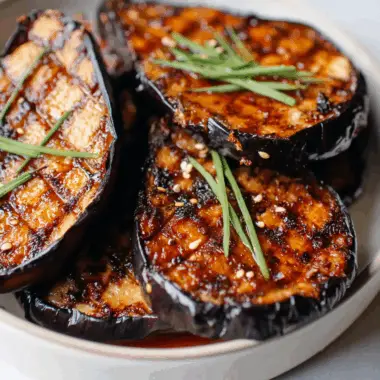Why Pork Ribs?
Pork ribs are an ideal cut of meat for slow-cooking and glazing due to their tenderness and the richness of the fat. When cooked low and slow, the meat becomes succulent, and the flavors from the sauce penetrate deeply into the ribs. The ribs also have a lot of connective tissue, which breaks down during cooking, making them incredibly tender and juicy.
This recipe is particularly suited for those who enjoy Asian-inspired flavors, as the sauce is heavily influenced by classic ingredients found in Chinese and Japanese cuisines. The balance of salty soy sauce, tangy rice vinegar, sweet mirin, and rich sesame oil makes for a deeply flavorful sauce that pairs perfectly with the tender pork.
The Perfect Combination of Ingredients
The ingredient list for these Sticky Asian Pork Ribs is simple but packed with flavor. Here’s why each ingredient plays a crucial role in making this dish stand out:
-
Pork Ribs: The star of the dish. Their natural tenderness and marbling make them perfect for slow cooking, ensuring that every bite is juicy and flavorful.
-
Soy Sauce and Dark Soy Sauce: These add a rich umami flavor and depth to the sauce. The dark soy sauce adds color and a more robust flavor, which is optional depending on your preference for color and taste.
-
Rice Vinegar: Adds a tangy element that balances out the sweetness of the sugar and mirin, providing a much-needed contrast to the richness of the pork.
-
Mirin: A sweet rice wine that adds a slight sweetness and a bit of acidity to the sauce, balancing the saltiness of the soy sauce.
-
Brown Sugar: Sweetens the sauce, helping to form a sticky, caramelized glaze on the ribs. You can substitute white sugar if preferred, but brown sugar adds a richer flavor.
-
Oyster Sauce: Brings an extra layer of umami and depth to the sauce. It is a key ingredient in many Asian dishes and works wonderfully in this recipe.
-
Sesame Oil: Adds a distinct nutty flavor that elevates the entire dish and provides a unique aromatic quality that is characteristic of many Asian recipes.
-
Ginger and Garlic: These two ingredients add fragrance and a zesty kick to the sauce, complementing the richness of the pork and providing a flavorful depth.
Step-by-Step Instructions
-
Prepare the Ribs: Start by removing the back membrane (silverskin) from the pork ribs. This membrane can be tough and chewy, so it’s best to remove it to ensure that the ribs are tender. After removing the membrane, cut the rack of ribs into smaller pieces along the bones. This makes them easier to handle and allows for better seasoning penetration.
-
Brown the Ribs: In a large pot, heat a little oil and brown the ribs on all sides. This step adds a deep, caramelized flavor to the meat and helps to develop the crust that will enhance the final dish. Browning the ribs also helps seal in the juices.
-
Prepare the Sauce: After browning the ribs, remove any excess oil from the pot with a paper towel. Then, sauté the ginger and garlic for a few minutes until fragrant. This step will release their aromatic oils, infusing the dish with their essence. Add the soy sauce, rice vinegar, mirin, brown sugar, oyster sauce, dark soy sauce (if using), and sesame oil to the pot. Stir to combine and create a flavorful marinade.
-
Simmer the Ribs: Bring the sauce to a boil, then add the browned ribs back into the pot. Reduce the heat to low, cover the pot, and let the ribs simmer for about 45 minutes, or until they are fork-tender. This slow cooking process allows the ribs to absorb all the flavors from the sauce and become incredibly tender.
-
Reduce the Sauce: Once the ribs are tender, increase the heat to medium, remove the lid, and let the sauce reduce for about 10 minutes. This will thicken the sauce and create a glossy, sticky glaze that coats the ribs.
-
Serve: Once the ribs are cooked and the sauce has reduced, remove the ribs from the pot. Garnish with green onions, fresh chilis, and sesame seeds to add a burst of freshness and a little heat. Serve the sticky pork ribs hot, paired with steamed rice or your favorite side dishes for a complete meal.
Serving Suggestions and Garnishes
These Sticky Asian Pork Ribs are rich and flavorful on their own, but you can elevate them further with some simple garnishes and side dishes:
-
Garnishes: Green onions, sesame seeds, and sliced chilis make for an excellent garnish. The green onions add a fresh crunch, the sesame seeds provide a subtle nuttiness, and the chilis give the dish an extra spicy kick.
-
Side Dishes: Serve these ribs with steamed jasmine rice, sautéed vegetables, or a simple salad to balance out the richness of the meat. You can also serve them alongside stir-fried vegetables or Asian slaw for an added crunch.
Conclusion: A Flavorful and Tender Dish
These Sticky Asian Pork Ribs are the perfect combination of tender meat and bold flavors. With a rich, savory sauce that balances sweet, tangy, and umami notes, this dish will become a favorite for any dinner or gathering. The slow-cooked ribs absorb the marinade’s flavors, resulting in a succulent, sticky glaze that makes every bite irresistible. With simple ingredients and easy-to-follow steps, these ribs are a fantastic way to enjoy a delicious Asian-inspired dish at home.








